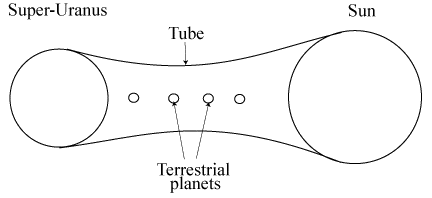
Fig. 14.1
Legend has it that the world passes through cycles of history, each of which is terminated by either fire or water. But what gave rise to such legends? According to Immanuel Velikovsky, they probably arose, in part, from events that accompanied the Earth’s encounter with a giant comet in the second millennium BC.
But this comet was not one of those flimsy little things known to orthodox astronomers as the ghosts of the solar system. This comet was a far more fearsome beast that stalked menacingly about the solar system, raining fire upon the Earth, and leaving its terrible imprint on the mythologies of those peoples unfortunate enough to witness the encounters. Velikovsky’s comet never did things by halves.
Velikovsky published several books about catastrophic influences in world history, but the most famous of these by far was his book Worlds in Collision.
The theory goes like this. Contrary to the opinion of orthodox astronomers, the solar system was not the same a few thousand years ago as it is now. The Earth was closer to the Sun, the Moon was more distant from the Earth, and the planet Venus didn’t even exist.
Then, sometime before the middle of the second millennium BC, there was a great commotion on the planet Jupiter, and a huge comet, later to lose its tail and become the planet Venus, was expelled violently from it. The Venus Comet shot out into the solar system and adopted a highly elliptical orbit about the Sun, which path carried it across the orbits of both Earth and Mars. Straight from the start, then, there was a danger of collision, though the title of Velikovsky’s book is actually something of a misnomer, since nowhere in it did Velikovsky claim that worlds actually collided. Rather, Velikovsky’s “collisions” are to be interpreted as somewhat hair-raising near-misses!
Be that as it may, twice in the 15th century BC the Venus Comet, with its spectacular trailing tail, approached the Earth and all hell was let loose. Earthquakes, volcanoes and tidal waves were generated by the forces of attraction between the Comet and the Earth. Violent electrical discharges shot back and forth between the two bodies, and in the commotion the polarity of the Earth’s magnetic field was reversed. The rate of the Earth’s spin on its axis was affected too. As a result of the latter, the Sun seemed to stand still in the sky, and other parts of the world experienced a prolonged night. The Earth rocked on its axis, and on at least one occasion, it tipped completely upside down, so that the Sun rose where once it had set, and vice versa.
The year lengthened as the Earth was pushed further from the Sun, and the Moon’s orbit around the Earth was seriously disrupted. Showers of meteorites tumbled from the sky, and clouds of dust and gas from the Comet’s tail descended to pollute the atmosphere, and in some places, to blot out the light of the Sun altogether.
Tidal waves swept around the world, giving rise to the ubiquitous legend of the Great Deluge, and as the gases of Venus’s cometary tail reacted with the oxygen of the Earth’s atmosphere, naphtha or crude petroleum was formed. Some of this burned fiercely – hence those legends of destruction by fire – and some of it, in liquid form, soaked into the ground to form some of the oil fields known to us today.
They were stirring times, those days of the Venus Comet. Their memory, Velikovsky claims, is preserved in the myths associated with the destruction of the world, the disruption of natural order, and the wars of the gods. The battle between Zeus and Typhon, the legend of Phaethon, the floods of the Epic of Gilgamesh and the Greek Deucalion, not to mention the plagues of the Exodus, are all ‘memories’ of the catastrophes associated with the Earth’s encounter with the Venus Comet. Legends from Greenland and Mexico, China and Peru, Scandinavia and Polynesia, Japan and Africa, all tell the same story, Velikovsky assures his readers. True, these myths and legends frequently describe the events in veiled and jumbled terms, but nevertheless the terms are plain enough for those who know what they are looking for. At least, according to Velikovsky they are. Conventional scholars have other ideas. They claim that these same legends have much less dramatic explanations which do not entail global catastrophes and rampaging planets. They also claim that Velikovsky is very selective in the way he handles his evidence, often ignoring material which doesn’t support his theories.
Velikovsky had a ready and ingenious explanation for why some of these myths and legends are on the vague side, and why our history books contain not a single explicit reference to these extraordinary events. He believed that the human race had been so traumatised by these catastrophes that the memory of them was effectively erased from our collective subconscious as time rolled on. He called this his hypothesis of collective amnesia. Orthodox scholars called it his excuse for flagging evidence.
But let’s get back to the Exodus, as it is Velikovsky’s reinterpretation of this part of the Bible which makes up a crucial part of his thesis.
In Ex. 7.17–21, the Nile is turned to blood, the fish die and the river stinks. This, of course, was caused by the reddish cometary dust, poisonous to fish, and a harsh irritant to the skins of man and beast alike – hence also the plague of boils and sores in Ex. 9.8–11.
As the comet drew closer to the Earth, swarms of meteorites tumbled noisily from the sky – hence the “grievous hail” of Ex. 9.18 and “the almighty thunderings and hail” of Ex. 9.28. With the closest approach of the comet came the plague of “darkness which may be felt” (Ex. 10.21–23); earthquakes (Velikovsky’s interpretation of the tenth plague of Ex. 12.29); and hurricanes, the “mighty strong west wind” of Ex. 10.19. All these, he claims, are symptomatic of a catastrophic encounter with a giant comet. Incidentally, the comet itself is the “pillar of cloud and fire” in Ex. 13.21.
As to the parting of the Red Sea with “a strong east wind”, Velikovsky argues that this was produced by a combination of hurricane-force winds and monstrous tidal forces which, whilst rolling tidal waves around the rest of the world, obligingly held the Red Sea apart for the Israelites to cross.
The Exodus, then, is one record of this world-wide cometary disaster in the fifteenth century before Christ.
As we said earlier, the Earth suffered two such encounters at that time, separated, Velikovsky claimed, by a period of fifty years. The Venus Comet then retreated, and though it continued to move in an erratic orbit around the Sun, it no longer threatened the Earth.
It did, however, have a catastrophic encounter or two with Mars, and this had two effects. First, it diverted Venus into its present nearly circular orbit around the Sun; secondly, it sent Mars into an orbit which brought it catastrophically close to the Earth every fifteen years. Incidentally, when Venus and Mars collided – in the eighth century BC, according to Velikovsky – the asteroids were formed, this neatly explaining something that has puzzled orthodox astronomers for many years.
Not being as heavy as the Venus Comet, which by the eighth century BC was starting to lose its tail and become a planet, Mars was considerably less dangerous. Even so, encounters with Mars were not to be sneered at, and they brought about the downfall of the Etruscan civilisation and the decimation of the army of Sennacherib (II Kings 19.35). They also explain why Mars came to be regarded as the god of war, and they provide Velikovsky with the basis for an entertaining reinterpretation of Homer’s Iliad in terms of a cosmic saga rather than a human one. But that is a debate in which we propose not to get entangled here!
After the catastrophic encounter of 23rd March 687 BC, on which occasion Sennacherib’s army was destroyed and the Moon’s surface was boiled up into its present cratered form, Mars settled into its present orbit. Since the seventh century BC, then, all has been comparatively quiet on the planetary front.
All this is the briefest summary of Velikovsky’s extraordinary book Worlds in Collision. Its publication in 1950 caused an uproar which has not entirely subsided even yet.
Generally speaking, scientific eccentrics do not have much power, official or otherwise. The main modern exception is Trofim Lysenko, who succeeded in putting back the science of genetics in the Soviet Union by at least twenty years. Velikovsky has never had official backing; nonetheless, he has become very much a cult figure, not only in the United States but also in some other countries. One hears him compared favourably with Newton, Galileo and Einstein. Why?
Well, there can be no doubt of the amount of scholarly research that has gone into Worlds in Collision and its successors. Every literary reference is correct, and there are many of them. In fact, we have a classic case of excellent research being twisted into an eccentric theory – just as one author proved, some years ago, that according to Hamlet, Shakespeare must have been a scratch golfer; again, every reference quoted from the Bard’s work was correct. Readers are impressed by this sort of thing, and Velikovsky does it very well indeed. He also writes well; and his doctorate is genuine enough. What is too easily forgotten is that although he knows a great deal about the Bible and such like, his knowledge of astronomy and physics leaves much to be desired. (This he demonstrated in his booklet Cosmos Without Gravitation, published in 1946.)
Secondly, there is no doubt that in tackling Velikovskianism, scientists made some grave errors of judgement. When Worlds in Collision first came out, it was greeted with considerable amusement – just as would have been the fate of a new book proclaiming the Earth to be flat – but also some alarm, because it was put out by an erstwhile respectable publisher (Macmillan) and was advertised as a new, profound, important and far-reaching work. Because of its erudition (so far as its literary dexterity was concerned), it started to have a real influence. Had scientists continued to chuckle at it, the whole episode would probably have been over in a few months. Instead, Velikovsky was bitterly attacked, and some educationalists threatened to boycott the whole of the Macmillan list unless Velikovsky was removed. This was duly done; but it made Velikovsky into a martyr, and he benefited hugely.
Thirdly, there was the point made earlier: Velikovsky virtually made up his own brand of astronomy and physics to accommodate his historical reconstruction, so that there was little common ground on which to base a sensible argument. Orthodox scholars argue that the most elementary mathematics will show that the whole concept of an object of the mass of Venus being shot out of Jupiter is absurd. Velikovsky and his followers, however, postulate hitherto unheard of mechanisms by which they claim this could have happened. Likewise, orthodox scholars claim that the orbital changes involved in Velikovsky’s scenario are impossible, and again Velikovsky and his followers step in with hypothetical forces which they claim can account for such changes. Orthodox scholars also believe that Velikovsky’s time scale is all wrong. For instance he believed the lunar features to be only a few thousand years old instead of a great many millions. The Velikovskians however dispute the methods by which the scientists arrive at their conclusions. Occasionally Velikovsky did hit the nail on the head (e.g. the high surface temperature of Venus and the radio noises from Jupiter) – but whenever he did so, it was always for the wrong reasons, and much more often he was wrong (e.g. he predicted that the Martian atmosphere would be made up of argon, neon and nitrogen; actually, it is almost pure carbon dioxide.) All of which goes to show that if you make enough predictions, some of them must be right.
Eventually the scientists had had enough. They challenged Velikovsky to defend his theories in a public symposium, and he duly did so; the results were published in a book in 1977, Scientists Confront Velikovsky, edited by Donald Goldsmith. In the end, Velikovsky’s own contribution was not included, simply because he refused to allow it to go through. Orthodox scholars considered that the symposium had torn Velikovsky’s whole picture to shreds. Velikovsky’s supporters had other ideas. The American Velikovskian journal Kronos launched its own counter-attacks with issue number 10, Scientists Confront Scientists Who Confront Velikovsky. The debate went on, then, reaching ever dizzier heights – or murkier depths, depending on how you look at it – not just in America but here in England, too, under the auspices of The Society for Interdisciplinary Studies. Worlds in Collision was just the beginning.
(For interested readers, the Society for Interdisciplinary Studies still continues – see: http://www.sis-group.org.uk/. For the journal Kronos, which ceased publication in 1988, see http://en.wikipedia.org/wiki/Kronos_(journal), but for list of contents of all its issues, see http://www.catastrophism.com/cdrom/pubs/journals/kronos/index.htm. Kronos Press still continues, see http://www.kronos-press.com/. The catastrophist journal that succeeded Kronos was Aeon – see http://www.aeonjournal.com/.)
Among Velikovsky’s followers special mention must be made of Professor Alfred de Grazia, a professor of Social Theory at New York University. He has taken Velikovsky’s ideas as a starting point and turned them into a whole new way of looking at the world, from astrophysics to psychology, and from geology to the origins of human speech. He calls his system Quantavolution which means, roughly, that the solar system, and in particular our Earth, have come to be as they are, not through gradual evolutionary processes, but through dramatic transitions related to Velikovsky-style planetary catastrophes. Professor de Grazia has published a series of fifteen volumes on his quantavolutionary theories (full details can be found on his website – http://quantavolution.net), and fascinating reading they make even if, like us, you find it difficult to believe more than about one word in ten. We shall concentrate here on one volume of that series, Solaria Binaria, published in 1984, which he co-authored with Earl R. Milton, Associate Professor of Astronomy at Lethbridge University in Alberta. If our readers find the following account of the history of the solar system rather unbelievable, they should remember Professor Milton’s qualifications!
As the title of the book suggests, the authors believe that our Sun was once one half of a binary star. This binary star was formed when a primitive Sun, containing about 11% more matter than our present Sun, became unstable and “fissioned” or split into two parts. (It should be said here that Professors de Grazia and Milton postulate involved electromagnetic mechanisms in their model, mechanisms quite unrecognised by most orthodox astronomers. So, on their model, a star can become electrically unstable and “fission” in this way.) One of these parts is our present Sun and the other they call Super-Uranus. Between the Sun and Super-Uranus was a sort of tube of material or debris, held in place by electromagnetic forces, and in this tube, from the debris of the fissioning process, were formed the so-called terrestrial planets, Mercury, Earth, Mars and Apollo. If our readers wonder where Venus has got to, and why Apollo has put in an appearance, well, we’ll return to that below. This fissioning process, incidentally, took place about 1 million years ago. (Such a late creation poses no problem for dedicated quantavolutionists, for they can easily explain the errors of conventional scientists who see everything taking place in millions and billions of years!) For the record, the Sun and Super-Uranus were separated by about 65 million miles. The terrestrial planets occupied the zone between 38 and 60 million miles from the Sun, though they didn’t orbit the Sun independently, as they do now, being held inside the tube. Fig. 14.1 will make the configuration clear.

Fig. 14.1
For many thousands of years the dust and debris in the tube would have obscured a direct view of either the Sun or Super-Uranus, and according to Professors de Grazia and Milton it was only about 13,000 years ago, with a thinning of the debris in the tube, that men became aware of them as heavenly bodies. Before then the world had been illuminated by diffused light, and also, incidentally, by a sort of ‘neon tube’ glow set up by electrical interchanges between the Sun and Super-Uranus. Super-Uranus appeared as a luminous disk about twice the size of our present Sun, and with the earth locked in a position about two-thirds of the way along the tube from the Sun end, the Sun would at that time have appeared about five times its present size. We should perhaps mention that the Earth was also locked with its then north pole facing Super-Uranus and its then south pole facing the Sun, but that is by the way.
Then Super-Uranus became unstable, and shells of matter were exploded out of it at intervals. This sequence of events is preserved in Indian mythology, our authors add, for we hear of the Cosmic Egg (Super-Uranus), which floated for thousands of years in the primordial waters (= space) until it ‘burst’ (= nova stage, and ejection of shell) to reveal the Lord of the Universe (the next phase of the Super-Uranus.) This apparently went on until about 11,000 years ago when Super-Uranus itself fissioned and ejected a huge chunk of itself down the magnetic tube towards the Sun. This chunk was Uranus Minor, and on its way down the tube, so to speak, it had a close encounter with the Earth. During this encounter our present Moon was torn from the Pacific Basin of the Earth, the Earth’s tectonic plates were formed (not millions of years ago, note, as conventional geologists claim!), and the present geography of our modern world was established. Uranus Minor was also responsible for dumping a deluge of water on the Earth as it passed by, and this was the beginning of our present oceans. (More water was dumped later, as we shall see.)
As Uranus Minor passed by the Earth it was deflected, and then further deflected by the Sun, so that it settled into an orbit entirely outside the binary pair. It became the planet Uranus known to us today. Meanwhile, back at the other end of the tube, Super-Uranus had turned into Super-Saturn – hence, our authors claim, the Greek legend that Saturn was the son of Uranus (i.e. formed from Uranus.) It appeared as a dull red disk, about three times the size of the present Sun.
But Super-Saturn was not stable, and eventually fissioned into at least three major fragments, these becoming the planets Jupiter, Saturn and Neptune. Jupiter orbited the Sun at about the Earth’s present distance, Saturn moved out beyond Mars’s present orbit, and Neptune moved out further still, somehow managing to dump yet another deluge down the tube and onto the Earth. This deluge occurred about 5700 years ago and is known to us as Noah’s Flood. It topped up the oceans, started by Uranus Minor, to their present levels, and this neatly explains why Neptune is a god of the sea. This major disruption of Super-Saturn apparently also resulted in the disruption of the tube, and for the first time the planets Mars, Earth, Apollo and Mercury began to orbit the Sun independently. This was bad luck for Apollo, as he had a disastrous encounter with Jupiter, the end result of which was a lot of asteroids and no more Apollo.
Jupiter was now the binary partner of the Sun, of course, and it is no accident that in mythology Jupiter is the god of the thunderbolt. Electrical discharges still passed between the planet and the Sun, and every so often, when the Earth passed between the two, it got zapped with a cosmic thunderbolt. The idea that Jupiter governed thunder and lightning in ordinary atmospheric storms was simply developed from this cosmic original.
The rest we know from Velikovsky. Venus was expelled from Jupiter, Mars dive-bombed the Earth, and after some involved planetary manoeuvres, the solar system settled into its present configuration just after 700 BC.
These, then, are some of the later developments of Velikovsky’s theories, and whilst we are about it we should perhaps mention some of the ideas put forward by some other followers of Velikovsky. Again, they make interesting reading even if we ourselves cannot believe them. For example, Ralph Juergens believes that Tycho, the most prominent crater on the Moon, was gouged out by an electrical discharge springing from that part of the Moon’s surface, and earthing, if you’ll pardon the expression, at the South Spot (or Arsia Mons) on Mars. Talking of thunderbolts, Dwardu Cardona follows Velikovsky in claiming that ancient references to the sulphurous smell of the thunderbolts hurled by Jove may be a memory of the nuclear transformation of atmospheric oxygen into sulphur. This could only be effected, it is claimed, by a cosmic thunderbolt, since ordinary thunderbolts cannot accomplish such a thing. When we pointed out to Mr Cardona that the “sulphurous smell” reported by the ancients might refer to the pungent smell of ordinary ozone, which is produced when ordinary lightning strikes, and which is often reported, he declined to comment. “I have long made it a rule never to defend any of my published work in private”, he replied to us somewhat huffily, though to be fair he did suggest that we might like to enter into a debate in the pages of the then current Kronos journal. In recent years, two of Velikovsky’s followers, David Talbott and Wallace Thornhill, have even written an entire book about cosmic thunderbolts. Entitled Thunderbolts of the Gods, it introduces the reader to “an age of planetary instabilities and earth-shaking electrical events in ancient times.” Finally, let us not forget Herbert C. Kaufman, who believes that the Egyptian god Ammon was associated with the planet Jupiter, and that it is no accident that Ammonia is found in the atmosphere of that planet. The Egyptians discovered this when the Earth and Jupiter had a close encounter of a Velikovskian, and, one imagines, pungent kind!
But Velikovsky is not the only contender in the catastrophe stakes. Two of his predecessors, William Whiston and Ignatius Donnelly (“The Prince of US Cranks”) were mentioned in Can You Speak Venusian? But there is a third, much neglected, contender in this field, William Comyns Beaumont.
Beaumont’s theory does not have Jupiter erupting, nor Venus changing from a comet into a planet, nor Mars doing a military three step about the solar system in the eighth century BC. It introduces only one approach by a giant comet, some time during the fourteenth century BC, and yet, simpler as this theory is at first sight, it has altogether more complicated and astounding implications for world history than the wildest Velikovskian dream. For Beaumont rearranges not only world history, but its geography as well!
Beaumont was an English journalist who developed his catastrophic reinterpretation of world historical geography as early as the 1920s. By the time of his death in 1955 he had published four books on the subject and prepared the manuscript of a fifth. Though his extraordinary ideas preceded Velikovsky’s, and foreshadowed many of them, the conclusions are very different and much less well known. Accordingly, with the help of Robert C. Stephanos, Beaumont’s leading convert, we would like, in some small way, to help rectify this imbalance of fame.
Mr Stephanos was born in 1925 and has followed the careers of psychologist and teacher. About 1950 he became a student of catastrophism and for some time was a close associate of Velikovsky himself. But once having fallen under the spell of Velikovsky’s less illustrious opponent, Comyns Beaumont, there was no looking back. Velikovsky was wrong and Beaumont was right. So, in 1975, he founded “the Beaumont Society”. Its objects were to publicise more widely Beaumont’s extraordinary hypotheses and to publish his last catastrophic manuscript, The Great Deception.
No finer summary of Beaumont’s basic thesis exists than the following extract from Mr Stephanos’s booklet, Catastrophists in Collision, from which, with his kind permission, we take our chapter heading. It was published by the Society in September 1976:
Beaumont’s catastrophic theories, summarised from his four books, relate that sometime near 1322 BC, a comet or its fragments as a “twin comet” entering from the north-east to south-west grazed or struck the earth in the north of Europe and Britain. The concussion was so violent that it caused the earth’s axis to wobble and alter its inclination, causing changes in the climate as revealed by geology. This collision, because of its magnitude and severity, ended pre-existing civilisation by the most destructive natural catastrophe ever known in the annals of history. The disaster submerged the continent of Atlantis, or a great part of it. Beaumont believes this was the real Flood of Noah.
The centre of that pre-existing civilisation (Atlantis), he suggests, lay in the region now occupied by Scandinavia and Britain. Some time after the terrestrial cataclysm, and owing to the gradual chilling of the climate, survivors of this old northern civilisation spread southward to a sunnier clime, carrying with them the old traditions and legends, and founded the later civilisations of the Near and Middle East – Greek, Phoenician, Egyptian and Roman. This reverses the generally accepted geographical tenet that civilisation spread northward from the Middle and Near East.
The cometary encounter, then, gave rise to the same quota of tidal waves, earthquakes and general conflagrations as Velikovsky’s comet, but on a local rather than global scale. The world-wide legends came about via a spread of migrating peoples, carrying with them their myths and legends, which, though orthodoxy sees them as having developed in the Middle East, were actually originally developed in Britain and Scandinavia, the original site of these disasters. Even the familiar Bible stories are based on events which in the first instance took place in Britain. Their Middle Eastern associations are merely secondary mythological intrusions.
The name of Noah is today preserved in Glen Noe, and the true Ark drifted from Inverlochy down the Caledonian Chain. The Scottish Lochs are not the results of Ice Age glaciation, as orthodox geologists claim, but of forcible gouging by a grazing comet.
Sodom and Gomorrah are preserved in Sodbury and Loch Morar; the Biblical Lot and the Arthurian Lot of the Orkneys were one and the same; the Tribe of Ham gave their name to Hampshire; and before the Earth’s axis was tilted by the cometary collision, the climate of Britain-Atlantis was a perfect Eden.
Egyptian legends began here too. The Shetlands preserve the name of the evil god, Seth; the Faroe Isles were literally Pharaoh’s Isles; and the entrance to the Egyptian Underworld was Fingals Cave. Beaumont even deduced that all Egyptian history prior to the beginning of its twentieth dynasty actually took place in South Wales.
Greek history, too, began in Britain. The Argonauts gave their name to Argyle, Perseus and Erse are obviously linked; the Temple of Poseidon was a memory of McKinnon’s Cave; Parnassus, of Ben Cruachan; and Hades was located somewhere in the West of Scotland. Beaumont even attempted to track down the original Athens (the one in Greece being a mere copy), but, alas, was unable to find it, though he was reasonably sure that it too was in Scotland. Finally, Ben Nevis was the original Mount Olympus.
Now all this may sound a little far-fetched, and in fact Beaumont had considerable difficulties in getting his books published for just that reason. The publishing world regarded him as something of a crank, he once said. But of course we must remember that all revolutionary ideas induce such a reaction at first.
To get the full flavour of Beaumont you must read the originals. His geographical and chronological arguments are rather detailed and involved, so we merely quote some of the more extraordinary results here without giving a full account of their derivation, beyond certain obvious name similarities which orthodox historians dismiss (too readily, in our opinion) as ‘mere coincidence’.
Beaumont, then, has a whole dimension to his theory that has been totally missed by Velikovsky and his followers – that of geographical location. There are time-scale differences as well – for example, Beaumont dates the Exodus at 1334 BC, and Velikovsky at nearer 1500 BC – but the geographical issue rather dwarfs the chronological one. Stephanos argues that Velikovsky’s vision of history is like a two-dimensional drawing of a three-dimensional object: it is limited in value and of necessity distorted.
Consider the mystery of the Hyksos capital.
Let us explain. At one stage of its long history, Egypt was invaded by a warrior race called the Hyksos who erected their fortress-capital at a place called Avaris. But where actually was Avaris? Egyptologists have argued over this for years, but seem to basically agree that it was somewhere in the eastern part of the Nile Delta.
Velikovsky identifies it as the el Arish of today, a town on the eastern border of Egypt, and rather further east of the archaeologists’ estimates of its position. And this, claims Stephanos, shows the limitations of the Velikovskian model of world history, for in proving that el Arish was Avaris, Velikovsky has implicitly assumed that Biblical geography is correct.
It isn’t, of course. The events of the Bible, as we have seen, were legends based on actual events, people and places located in ancient Britain-Atlantis. But the truth of this has not just been forgotten, it has been deliberately obscured as well. Biblical history has been tampered with by Christian writers eager to give their religion an ancient and respectable pedigree. Towards the end of his life, Beaumont came to believe in a historical conspiracy, and it is this that is the theme of his unpublished manuscript.
Little wonder it was never published, for the book reveals either the most extraordinary fraud in history or else the peculiar paranoid delusions of its author. The publishers of its day chose to believe the latter.
Beaumont adduces evidence to show that medieval maps were tampered with by monkish cartographers so as to fall in line with the requirements of their biblical preconceptions and the theological tenets of their time. Real history and geography were suppressed and altered, and the firm relocation of biblical holy sites in the Near East was brought about largely by the decrees of Constantine the Great. So successful was his purge that we today are convinced that all this history really did take place in Egypt and Palestine, and so successfully have we been duped that when the truth is revealed to us, we reject it as ‘crank’.
Going back to Avaris, now, since Velikovsky assumes the correctness of biblical geography, he has been unwittingly duped so as to fall in line with the fabricated ‘history’ of medieval Christian fanatics. Avaris was not really in the Middle East at all, but in Britain, at the famous site of Avebury, the Borough of Avaris.
The Hyksos worshipped Set, otherwise known as Typhon, the Celestial Serpent, or personification of the comet. Avebury quite clearly expresses this in the symbolism of its layout (Fig. 14.2).
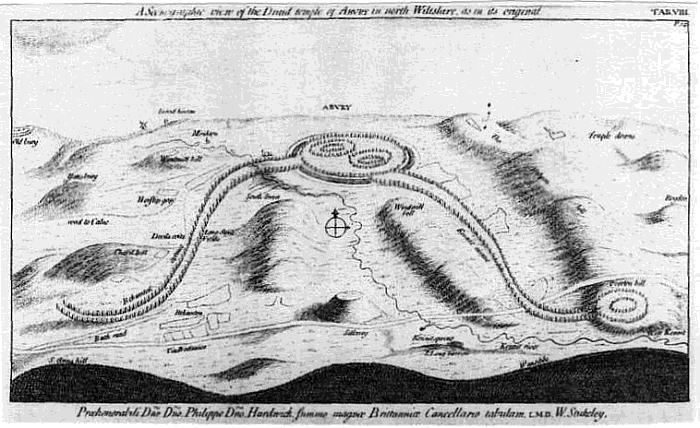
Fig. 14.2
From here it is but a short step to see that Shiloh was formerly Silbury Hill, and Hebron formerly Barbury Castle.
In the Bible, too, we hear of Mount Nebo, in the land of Moab, and Balak, the King of Moab. Can it be coincidence that in the hills just north of Avebury there is a Mount Nebo, and that on the Wiltshire-Berkshire border is a Balak Farm? Again, is it merely coincidence that an old name for the inhabitants of Worcestershire, Warwickshire and Gloucestershire was “Hwiccas”, a word which is similar in form to Hyksos?
It will now be clear why Mr Stephanos intended publishing Beaumont’s final work under the sub-title: After Atlantis: The Greatest Story Never Told. (Unfortunately, so far as we know, the book was never actually published.)
We close with Beaumont’s reconstruction of the Exodus, having given Velikovsky’s version elsewhere. Readers are advised to consult the accompanying map (Fig. 14.3) in order to get their minds attuned to Somerset rather than Egypt.
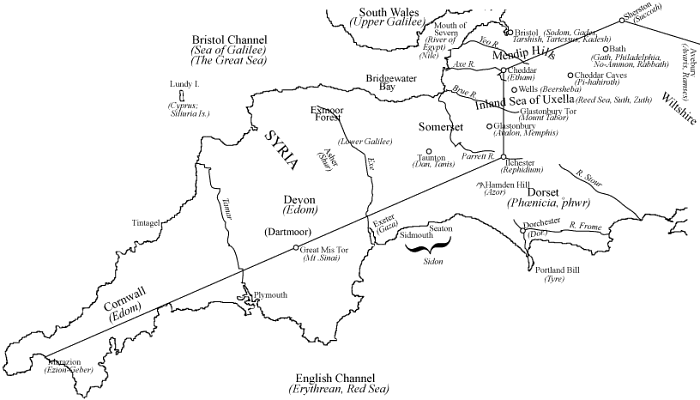
Fig. 14.3
The Exodus began at Ramses (near Avebury) and proceeded via Succoth (Sherston, in the Cotswolds) and Etham (in the Mendips) to Pi-hahiroth, “the mouth of caves” (Cheddar). Here came the crossing of the ‘sea’. Not the Red Sea, as is commonly assumed, but the valley of the Somerset River Axe, formerly known as the Northern Bay of Uxella, the inland sea.
The Bible story takes a bit of a knock at this point since Beaumont’s transference of geography implies a set of climatic conditions which favour a very ingenious explanation of the Exodus miracles. This explanation has hitherto been missed on account of the fact that the necessary climatic conditions just do not happen in the Middle East, the usually accepted scenario of the Exodus.
In Ex. 14.19–20 we read of the mysterious pillar of cloud that stood between the camp of Israel and the camp of the Egyptians, thus effectively shielding the former and aiding their escape. Might this not have been a typically English pea-soup fog?
And in Ex. 14.21 we have the famous parting of the Red Sea, so grandly portrayed in the movies. But it wasn’t quite like that according to Beaumont. Here is what Ex. 14.21 says:
And Moses stretched out his hand over the sea; and the Lord caused the sea to go back by a strong east wind all that night, and made the sea dry land, and the waters were divided.
Stephanos, following Beaumont, interprets this as follows:
In plain, everyday language, the waters of the inland sea were frozen over, congealed, and with this situation confronting them, the fugitives took the opportunity during a heavy night fog to cross over the frozen water. It was not a long crossing, but in the morning when the sun peeped through the fog and the host of Pharaoh saw they had eluded them, they chanced the crossing also, but their heavy chariots cracked the ice and they were drowned.
You’ve got to admit – it is certainly a novel idea! From the inland Sea of Uxella, it was south to Rephidim (Ilchester), where Moses struck “the Rock in Horeb” (Ex. 17.6) to procure water for the thirsty Israelites, before arriving at Mount Sinai (Great Mis Tor on Dartmoor) to collect the Ten Commandments (Ex. 19.2 ff.)
For some reason Velikovsky has never acknowledged his rival’s ingenuity. Mr Stephanos feels that this is not simply a lack of awareness on Velikovsky’s part, but an active evasion of a better and altogether more daring theory. Dr Velikovsky is now, alas, dead. It is to be hoped that his followers will give Robert C. Stephanos and the Beaumont Society a better reception. So far, though, there is no sign of this.
Another brand of cosmic catastrophe has been proposed by Réginald Trestournel of Sceaux in France, who in 1973 published a book called Terre, Planète Meurtrie (Earth, the Battered Planet). The book is largely an attempt to explain various geological formations and processes such as the folding of the Alps, Ice Ages, and Continental Drift, but it also, en passant, seeks to solve a riddle of Babylonian mythology – namely, the nature of the cosmic body depicted in various ancient stelae, such as that of Melishipak II (1186–1172 BC), shown in Fig. 14.4. The Sun and Moon are there, but just what is that extra star-like luminary on the left? Conventional scholars say that it is the planet Venus, emblematic of the goddess Ishtar, but just not drawn to scale. M. Trestournel, however, dubs it the Baryplanet, and that is the key to his theory.
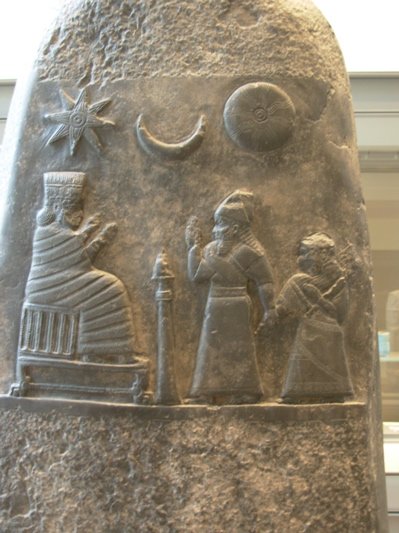
Fig. 14.4
The primitive Earth, he claims, was smaller than the Earth we know today, its radius being about 2900 miles as compared with the modern 3960 miles. It consisted mostly of rock, with little or no iron. It rotated about an axis perpendicular to the plane of the ecliptic (compare Firth Scott’s theory in Chapter 17: great minds think alike!) so that days and nights were of equal length all year round and there were no seasons, merely a perpetual spring. The climate was ideal and the vegetation luxuriant as a result. This was the Garden of Eden. There were no high mountains and no deep seas, and since the Earth was smaller then, the force of gravity was correspondingly less. This, according to M. Trestournel, was a key factor in the development of the gigantic dinosaurs.
At the end of the Tertiary Period a body about three times the size of the primitive Earth entered the solar system. This was the Baryplanet. For millions of years it orbited the solar system, approaching the Earth and then moving away again. But then came the collision. According to M. Trestournel the Baryplanet, which consisted mainly of iron, hit the softer rocky primitive Earth, and embedded itself into it as a cannonball would in a lump of dough. Fig. 14.5 will make this clear.
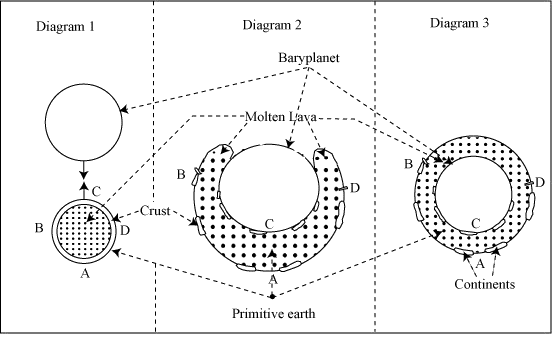
Fig. 14.5
M. Trestournel argues that the hard Baryplanet would have resisted all deformation, but that the impact would have partly melted the primitive earth, enough for it to mould itself around the Baryplanet and return to a spherical shape. This explains how the Earth came to have a rocky mantle and a metallic core, and provides the forces which produced the folding of mountains and the motion of massive continental ‘rafts’. It explains why the axis of the Earth is no longer perpendicular to the plane of the ecliptic (and hence why we now experience seasons). M. Trestournel’s scenario also explains the wiping out of large numbers of plants and animals – the extinction of species. Furthermore, with the increased mass of the Earth, and hence the increased gravity, any surviving large dinosaurs would find movement suddenly more difficult, and this may rather neatly explain the final extinction of these creatures, a subject we shall return to in the next chapter. We put it to M. Trestournel that any creature would have been unlikely to survive such an impact, let alone live on to struggle against increased gravity, but he was quite adamant that this was possible for creatures on the opposite side of the primitive earth from the point where the Baryplanet hit it.
According to M. Trestournel, the heat generated by the impact almost instantly vaporised a sizeable percentage of the oceans, forming dense clouds which virtually blotted out the Sun for many months. This was the start of the Quaternary Ice Age.
Of course, this was all very long ago, so how is it that the Baryplanet features on Babylonian stelae so many thousands of years later? The answer is that the memories of these events lodged in the subconscious of the human race, and were preserved in such mythological stories as that of Phaeton. All this, of course, brings us back yet again to Velikovsky, so there is little more to be said.
But if the Earth is not destroyed by a cosmic collision, can it end by going off “pop”? This is the theory propounded by a Swiss financier, Louis Jacot, whose book, Earth’s Flight Beyond, was published in French in 1977, and subsequently translated into English. It is without doubt one of the weirdest books of modern times, particularly since it was written by a man who had achieved distinction in other fields. It was written, as the author tells us in his Foreword, as “a protest against the tyranny of official science.”
Jacot was born in 1906, read law, and was called to the Bar in 1929. He was called upon to reorganize the Neuchâtel Canton Bank, and then entered the services of the Swiss Confederation, becoming head of its finance department. He took part in drawing up financial agreements between Switzerland and other states, and also lectured on financial matters at university level. It was only later that he entered the field of cosmology. So let us now listen to what he has to tell us.
First, the concept of universal gravitation is nonsense. It would apply only to a completely empty universe. But the universe is not empty; as the famous philosopher René Descartes had discovered long before, it is filled with a host of contiguous vortices which are of supreme importance. According to Bode’s Law, the distances of the planets from the Sun can be expressed as a geometric progression, with 2 as the common ratio (this is not quite true – see the beginning of Chapter 8 for details); this is the simple result of the centrifugal force of the vortex movement, and means that planets are periodically expelled from the Sun and then move progressively away from it. In fact, the orbits of the planets are neither circles (as Ptolemy believed) nor ellipses (as Kepler maintained). They are spirals, and the Earth, like the other planets, moves further away from the Sun each year.
As they move away from the Sun, the planets move into zones of ether which are less and less dense. They are therefore subject to lesser compression, and expand. Originally the Earth did not rotate upon its axis; it kept the same face turned toward the Sun all the time. (M. Jacot added that this is how Mercury behaves now. In fact it doesn’t; Mercury takes 88 Earth-days to complete one orbit, but only 58½ days to spin once round.) From the original non-rotating stage, the Earth moved outward and entered the Venus stage, spinning very slowly; one day then lasted for several millennia. From then until the end of the Tertiary era, there were only six full rotations, which of course correspond to the six days of creation described in Genesis. With each rotation, huge ice-caps formed on the darkened hemisphere, which accounts for the four major glaciations ending at the start of the Quaternary era. Between glaciations, tropical vegetation spread as far as the polar regions.
Now we come to the arrival of the Moon – or rather its formation. The slow rotation made the Earth’s globe bulge out, until at last a chunk of it broke off to form the Moon, leaving the gaping hole now filled by the Pacific Ocean; this happened during the Tertiary era, during the sixth ‘day’. The land-mass was disrupted, so that the continents broke apart; mountain chains were formed because of pressures brought about by the flattening of the globe.
The slow phase of rotation ended with the final Ice Age. The rate speeded up, until a ‘day’ lasted for two months; the cycle of the seasons was due solely to this, which explains the chronologies and the longevity of the patriarchs. The change to a 24-hour rotation caused a general melting of the ice-caps, and, naturally, Noah’s Flood – dated about 3500 BC (the Earth itself, by the way, is no more than about 100,000 years old).
In future, the Earth will continue along the same lines. More moons will be ejected, and, in M. Jacot’s own words, “that part of the globe which will form the next moon is already marked by Destiny”. But what will happen then?
Presumably a new planet will be expelled from the Sun, and will spiral out to the present orbit of Mercury, while Mercury moves out to the present path of Venus, Venus into that of the Earth and so on – a sort of cosmic musical chairs. The Earth, of course, will move out to take the place of Mars, and Mars to Jupiter, which by then will have moved out to its Saturn stage – and so on. But remember! With every increase in distance, the ether pressure becomes less, and the final result is that when the pressure has been reduced to a negligible amount, the planet will explode. This is bound to happen first to Neptune and Pluto, then to Uranus, then to Saturn, Jupiter, and – horrors! – the Earth. If humanity survives until that epoch, we must be prepared not for the Big Bang, but for the Big Pop.
Comment seems to be superfluous. M. Jacot’s book is very detailed, and written with the care which one would expect from a trained legal mind. He describes his book as “a cry of alarm”, but at least there is time for us to take stock and see what can be done – if anything. No doubt we will find out eventually!
Before we leave Velikovsky and the catastrophists we must mention Elfriede Tingleaf, who once described herself to us as “a fuzzy little gray-haired old lady”, and who lived in Arizona, USA. Actually, Mrs Tingleaf was not a catastrophist as such. In fact, she once told us that she wasn’t even a Presbyterian any more. But she does belong in this chapter if for no other reason than that she was somewhat sceptical of our claims that Velikovsky often manipulated his sources into saying what he wanted them to say. This was because Mrs Tingleaf claimed to have found the source of some of Velikovsky’s sources, original and very ancient accounts of the planetary catastrophes, and the source of inspiration, too, for Homer’s Iliad and the dialogues of Plato. Incidentally, Mrs Tingleaf suspected that the latter may have been tampered with in the 10th century AD, and not written entirely by Plato in the 4th century BC, as orthodox scholars claim. But that is something that need not concern us here!
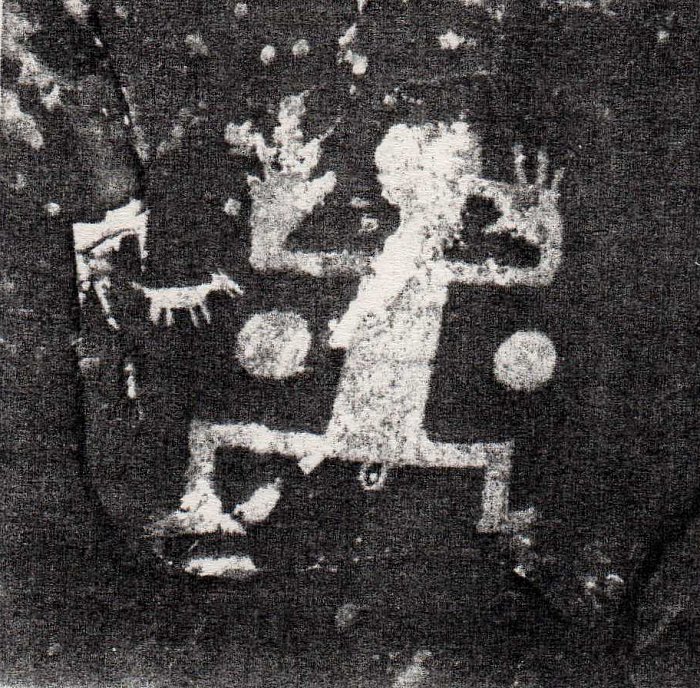
Fig. 14.6
So what are these sources of Velikovsky’s sources? Let’s start with Fig. 14.6, which is a rock carving in Arizona. According to Mrs Tingleaf, the principal figure in the middle represents “the androgynous native American god, the Aztec bisexual primordial expression of the divinity Ometeotl (twice god)”, Mother Earth and Father Sky, back to back, or side to side. Mother Earth is on the left, “her breast ripped out, and her benevolent hand on fire”. There is an unholy din, the noise of cosmic catastrophe, so unbearable that Father Sky, on the right, is plugging his ear. The disk to the left of Mother Earth is Venus. That to the right of Father Sky is Mars, and his ‘sons’ Deimos and Phobos. Here is Velikovsky’s scenario in primitive petroglyph form. (Incidentally, Mrs Tingleaf wasn’t at all sure what the donkey-like figure to the left of Venus was, but thought it might represent “the angry wolf star”.)
Our first reaction to all this was frankly one of scepticism. After all, the petroglyph is as much like a frog as anything else, and we did in fact put this to Mrs Tingleaf. Certainly an element of subjective interpretation is involved here, and Mrs Tingleaf freely admitted this. But as she pointed out, “Thunder”, as she called Fig. 14.6, is not alone.
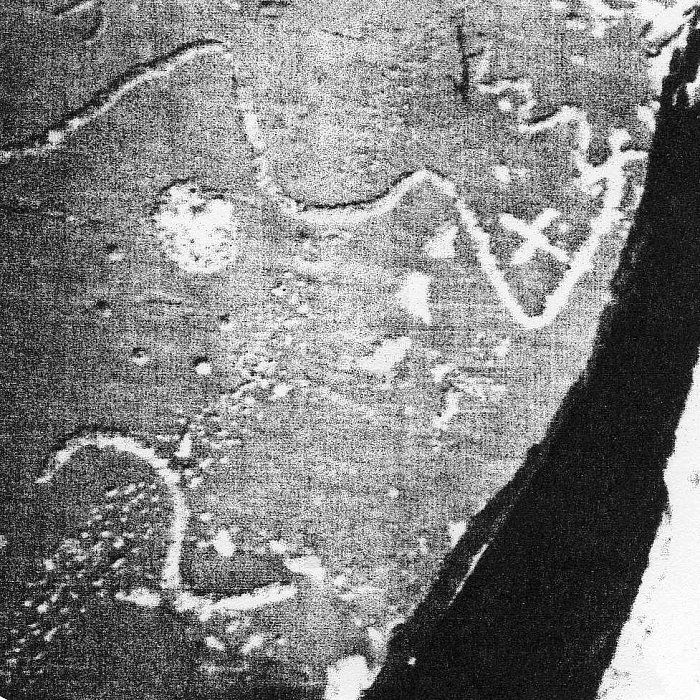
Fig. 14.7
Its message is backed up by another petroglyph on the same rock, here Fig. 14.7, which she says shows a meteorite shower coming from the north-west, possibly through the constellations of Draco and Boötes. Again, Mrs Tingleaf finds the same “coming-down-star” story in the petroglyphs recorded by A.P. Okladnikov along the Angara River in Siberia. This is our Fig. 14.8.
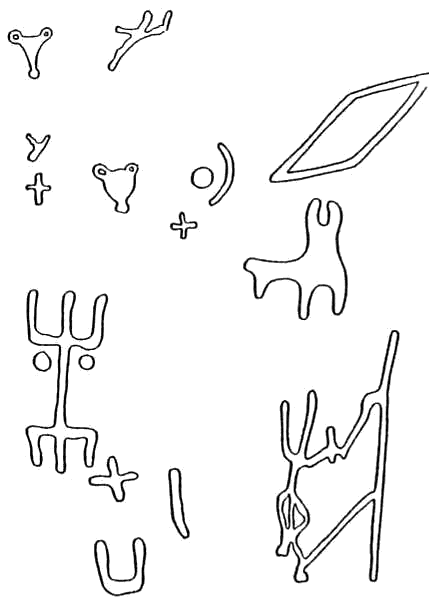
Fig. 14.8
Not only this, but the Superstition Mountains in Arizona tell a story of catastrophe on an altogether grander scale. According to Mrs Tingleaf “the rock formations have been ‘carved’ so that every change in angle of the Sun creates new and different pictures in highlights and shadows, providing a year-round continuous performance of moving pictures.” Who ‘carved’ them, when or how, Mrs Tingleaf had no idea, but she claimed that it is these “kinetic displays” of the Superstition and Goldfield Mountains which “were used by Homer in his mythistories, propounded by Plato as philosophy, sprinkled through the Bible, read by the Norse and Teutonic peoples, used by the Amerindians, and now being enjoyed by Tingleaf.”
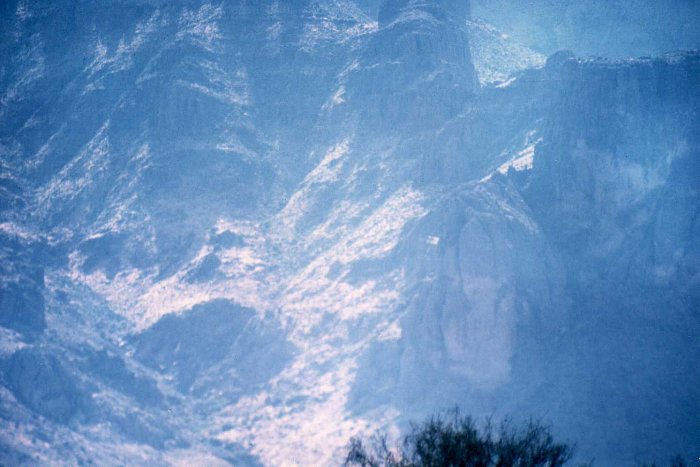
Fig. 14.9
For many years Mrs Tingleaf and her camera stalked the Mountains, at different seasons and different times of day, photographing these ‘sculptures’, as she called them. But are they really sculptures? Mrs Tingleaf sent us several examples, one (shown here as Fig. 14.9) purportedly showing Homer’s god Ares on the left, “now almost totally dissipated”, and Homer’s Athene on the right, “now quite frazzled, setting her last fire on Poor Tiger.” This scene appears in Homer’s Iliad, and according to Velikovsky it represents the clashes between the planets Venus and Mars. According to Mrs Tingleaf the Ares figure is a little bird and the Athene figure a fallow deer. Unfortunately our scepticism is aroused again, for these photographs look to us just like ordinary mountain scenes, and the ‘sculptures’ no more deliberate than the faces one sometimes sees in clouds or peeling paintwork. (There is, of course, a strong comparison with terrestrial zodiac hunting here.) Likewise, when Mrs Tingleaf told us that in the Goldfields, further to the north, is carved the story of Mars and Rhea Silvia, the wolf, and the birth of Romulus and Remus, well, we couldn’t help but wonder if Mrs Tingleaf was just seeing things.
Mrs Tingleaf also believed that she had located a map of Plato’s Atlantis on a sculpted rock in Arizona. According to the map, Atlantis is – and was, before it sank beneath the waves – a large island situated just where Plato said it was, beyond the Pillars of Hercules (the Straits of Gibraltar). At the risk of sounding repetitive, we wondered if Mrs Tingleaf’s map was really a map at all, or whether it was just a bit of stone that looked something like a map if you squinted a bit. Certainly geologists are confident that no large island ever sank at the place indicated by Plato and Mrs Tingleaf’s map. However, we leave our readers to make up their own minds, and reproduce the map here as Fig. 14.10. Incidentally, Mrs Tingleaf also came up with a map which, she claimed, “can ‘read’ the whole of the Western Hemisphere on a modern map by going in circles.”
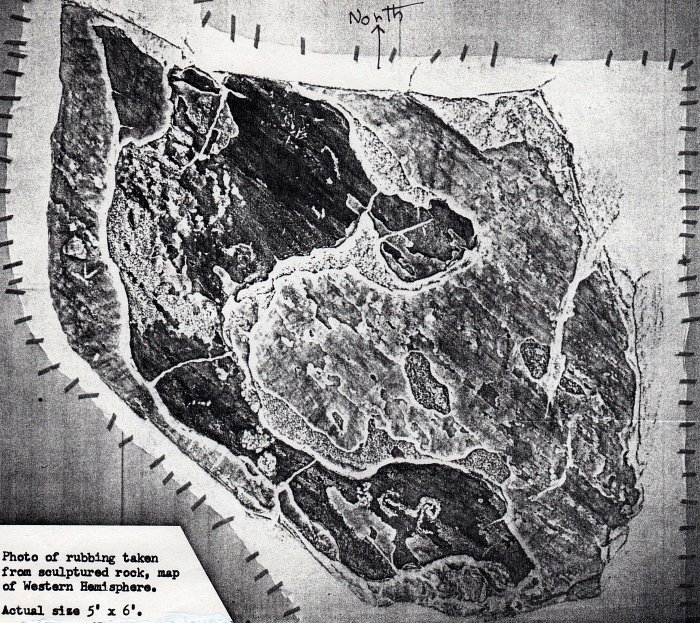
Fig. 14.10
Mrs Tingleaf’s views on the Exodus were similarly unorthodox. In one of her many fascinating letters to us she seemed to be implying that manna was derived from man-na, meaning “Hemp, please!” We wondered if this implied that the Israelites were hooked on drugs, but Mrs Tingleaf was quite emphatic: “I did not say that, you did. Any time you want to write up that, we’ll go back into the (Biblical) Garden of Eden and start with the original ‘Big Bhang’ theory!”
Some of Mrs Tingleaf’s conclusions were so strange that even she abandoned them. For example, she once set out to decipher a cryptic message from the Exodus plague story, when she realised that the Hebrew word for “locust”, ARBE, could be translated also as “barge”, and that ARB meant “lie in wait, ambush.” All day, far into the night, and all the next day until evening, she worked at it. Then at last, she told us, she found she had extracted the hidden significance: it was the Boston Tea Party! “That was too much for even me,” she told us, “so I ditched the whole lot into a folder and haven’t touched it since.”
Mrs Tingleaf’s observations on Homer’s Iliad were similarly startling. She thought that Achilles represented what might be called “the life history of iron”, that Ajax and Aeneas were catapult machines, and Hector a siege tower. As for Helen of Troy, it was Virgil, not Homer, who sprung the final clue to the truth of her identity. “The face that launched a thousand ships was the west coast of Denmark!” As for Zeus, in one of her early letters Mrs Tingleaf seemed to imply that there was some significance in the fact that Zeus read backwards was Suez, the famous canal. However, this turned out to be another of our misconceptions, and it later transpired that Zeus backwards was connected with Sus, the Latin word for hog or swine, and Ursus, the Latin word for a Bear. Any connections with the Suez Canal were purely fortuitous.
No doubt some people will dismiss Mrs Tingleaf’s observations with scorn as the ramblings of an old lady with a hyper-active imagination. But we can assure our readers that right or wrong, a letter from Elfriede Tingleaf was worth half a dozen from ordinary mortals!